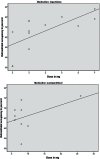Frontal D2/3 Receptor Availability in Schizophrenia Patients Before and After Their First Antipsychotic Treatment: Relation to Cognitive Functions and Psychopathology
- PMID: 26819282
- PMCID: PMC4886673
- DOI: 10.1093/ijnp/pyw006
Frontal D2/3 Receptor Availability in Schizophrenia Patients Before and After Their First Antipsychotic Treatment: Relation to Cognitive Functions and Psychopathology
Abstract
Background: We have previously reported associations between frontal D2/3 receptor binding potential positive symptoms and cognitive deficits in antipsychotic-naïve schizophrenia patients. Here, we examined the effect of dopamine D2/3 receptor blockade on cognition. Additionally, we explored the relation between frontal D2/3 receptor availability and treatment effect on positive symptoms.
Methods: Twenty-five antipsychotic-naïve first-episode schizophrenia patients were examined with the Positive and Negative Syndrome Scale, tested with the cognitive test battery Cambridge Neuropsychological Test Automated Battery, scanned with single-photon emission computerized tomography using the dopamine D2/3 receptor ligand [(123)I]epidepride, and scanned with MRI. After 3 months of treatment with either risperidone (n=13) or zuclopenthixol (n=9), 22 patients were reexamined.
Results: Blockade of extrastriatal dopamine D2/3 receptors was correlated with decreased attentional focus (r = -0.615, P=.003) and planning time (r = -0.436, P=.048). Moreover, baseline frontal dopamine D2/3 binding potential and positive symptom reduction correlated positively (D2/3 receptor binding potential left frontal cortex rho = 0.56, P=.003; D2/3 receptor binding potential right frontal cortex rho = 0.48, P=.016).
Conclusions: Our data support the hypothesis of a negative influence of D2/3 receptor blockade on specific cognitive functions in schizophrenia. This is highly clinically relevant given the well-established association between severity of cognitive disturbances and a poor functional outcome in schizophrenia. Additionally, the findings support associations between frontal D2/3 receptor binding potential at baseline and the effect of antipsychotic treatment on positive symptoms.
Keywords: SPECT; Schizophrenia; antipsychotic-naïve; cognition; epidepride; frontal dopamine D2/3 receptor; psychopathology.
© The Author 2016. Published by Oxford University Press on behalf of CINP.
Figures




Similar articles
-
Extrastriatal dopamine D2/3 receptors and cortical grey matter volumes in antipsychotic-naïve schizophrenia patients before and after initial antipsychotic treatment.World J Biol Psychiatry. 2017 Oct;18(7):539-549. doi: 10.1080/15622975.2016.1237042. Epub 2016 Oct 26. World J Biol Psychiatry. 2017. PMID: 27782768
-
Relationship of frontal D(2/3) binding potentials to cognition: a study of antipsychotic-naive schizophrenia patients.Int J Neuropsychopharmacol. 2013 Feb;16(1):23-36. doi: 10.1017/S146114571200003X. Epub 2012 Feb 17. Int J Neuropsychopharmacol. 2013. PMID: 22338593
-
Frontal fasciculi and psychotic symptoms in antipsychotic-naive patients with schizophrenia before and after 6 weeks of selective dopamine D2/3 receptor blockade.J Psychiatry Neurosci. 2016 Mar;41(2):133-41. doi: 10.1503/jpn.150030. J Psychiatry Neurosci. 2016. PMID: 26599135 Free PMC article.
-
[Cognition, schizophrenia and the effect of antipsychotics].Encephale. 2006 May-Jun;32(3 Pt 1):341-50. doi: 10.1016/s0013-7006(06)76162-0. Encephale. 2006. PMID: 16840928 Review. French.
-
Dopamine D2 and D4 receptor ligands: relation to antipsychotic action.Eur J Pharmacol. 1998 Jun 26;351(3):273-86. doi: 10.1016/s0014-2999(98)00312-4. Eur J Pharmacol. 1998. PMID: 9721018 Review.
Cited by
-
Identification of a Serotonin 2A Receptor Subtype of Schizophrenia Spectrum Disorders With Pimavanserin: The Sub-Sero Proof-of-Concept Trial Protocol.Front Pharmacol. 2020 Apr 30;11:591. doi: 10.3389/fphar.2020.00591. eCollection 2020. Front Pharmacol. 2020. PMID: 32425802 Free PMC article.
-
Advancing understanding of the mechanisms of antipsychotic-associated cognitive impairment to minimise harm: a call to action.Mol Psychiatry. 2024 Aug;29(8):2571-2574. doi: 10.1038/s41380-024-02503-x. Epub 2024 Mar 7. Mol Psychiatry. 2024. PMID: 38454078 Free PMC article. No abstract available.
-
Dopamine Dynamics and Neurobiology of Non-Response to Antipsychotics, Relevance for Treatment Resistant Schizophrenia: A Systematic Review and Critical Appraisal.Biomedicines. 2023 Mar 14;11(3):895. doi: 10.3390/biomedicines11030895. Biomedicines. 2023. PMID: 36979877 Free PMC article. Review.
-
Effects of risperidone/paliperidone versus placebo on cognitive functioning over the first 6 months of treatment for psychotic disorder: secondary analysis of a triple-blind randomised clinical trial.Transl Psychiatry. 2023 Jun 10;13(1):199. doi: 10.1038/s41398-023-02501-7. Transl Psychiatry. 2023. PMID: 37301832 Free PMC article. Clinical Trial.
-
In vivo absolute quantification of striatal and extrastriatal D2/3 receptors with [123I]epidepride SPECT.EJNMMI Res. 2020 Jun 16;10(1):66. doi: 10.1186/s13550-020-00650-0. EJNMMI Res. 2020. PMID: 32548681 Free PMC article.
References
-
- Abi-Dargham A, Xu X, Thompson JL, Gil R, Kegeles LS, Urban N, Narendran R, Hwang DR, Laruelle M, Slifstein M. (2012) Increased prefrontal cortical D(1) receptors in drug naive patients with schizophrenia: a PET study with [(1)(1)C]NNC112. J Psychopharmacol 26:794–805. - PubMed
-
- Beaulieu JM, Gainetdinov RR. (2011) The physiology, signaling, and pharmacology of dopamine receptors. Pharmacol Rev 63:182–217. - PubMed
-
- Brozoski TJ, Brown RM, Rosvold HE, Goldman PS. (1979) Cognitive deficit caused by regional depletion of dopamine in prefrontal cortex of rhesus monkey. Science 205:929–932. - PubMed
Publication types
MeSH terms
Substances
LinkOut - more resources
Full Text Sources
Other Literature Sources
Medical

